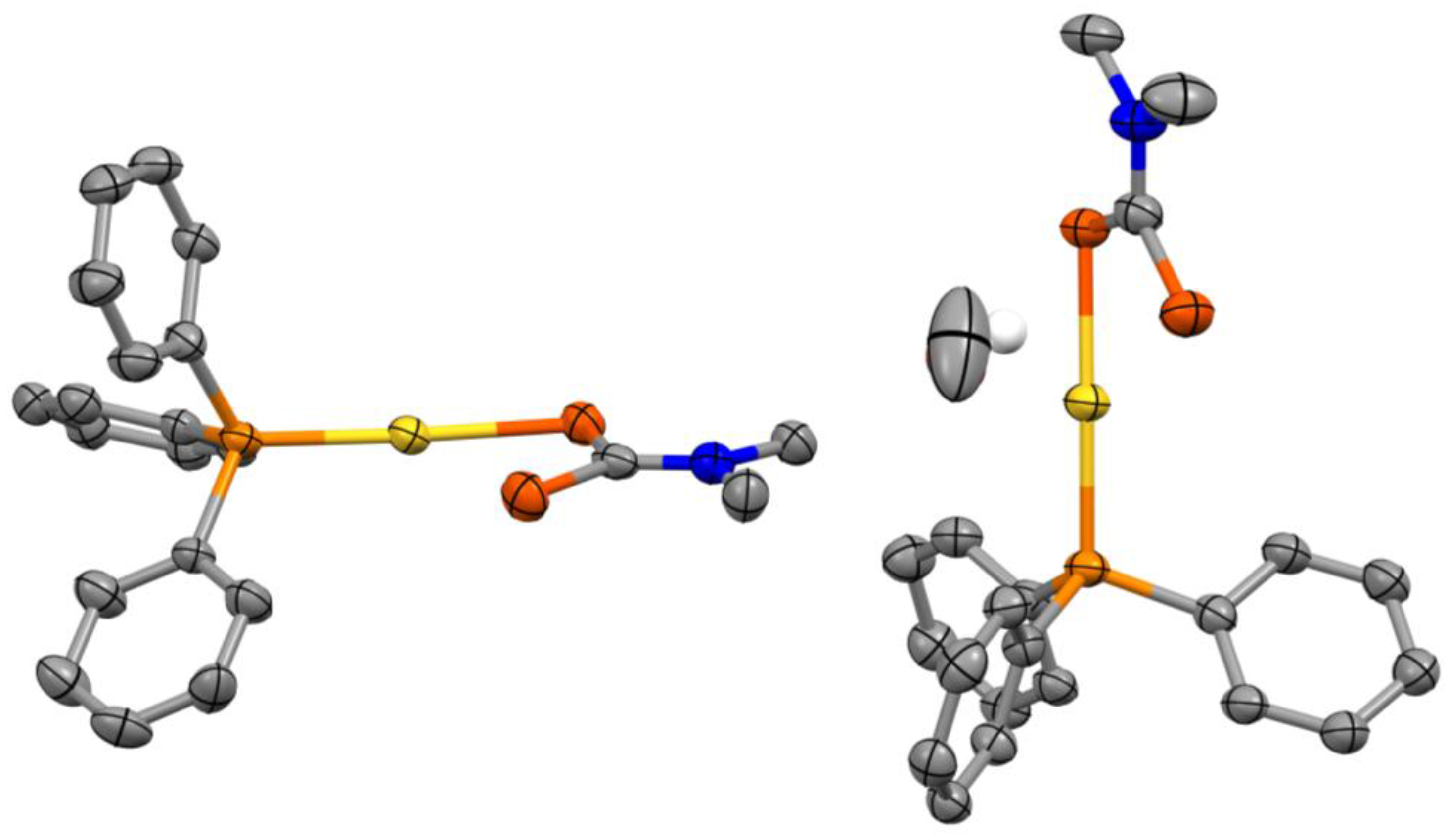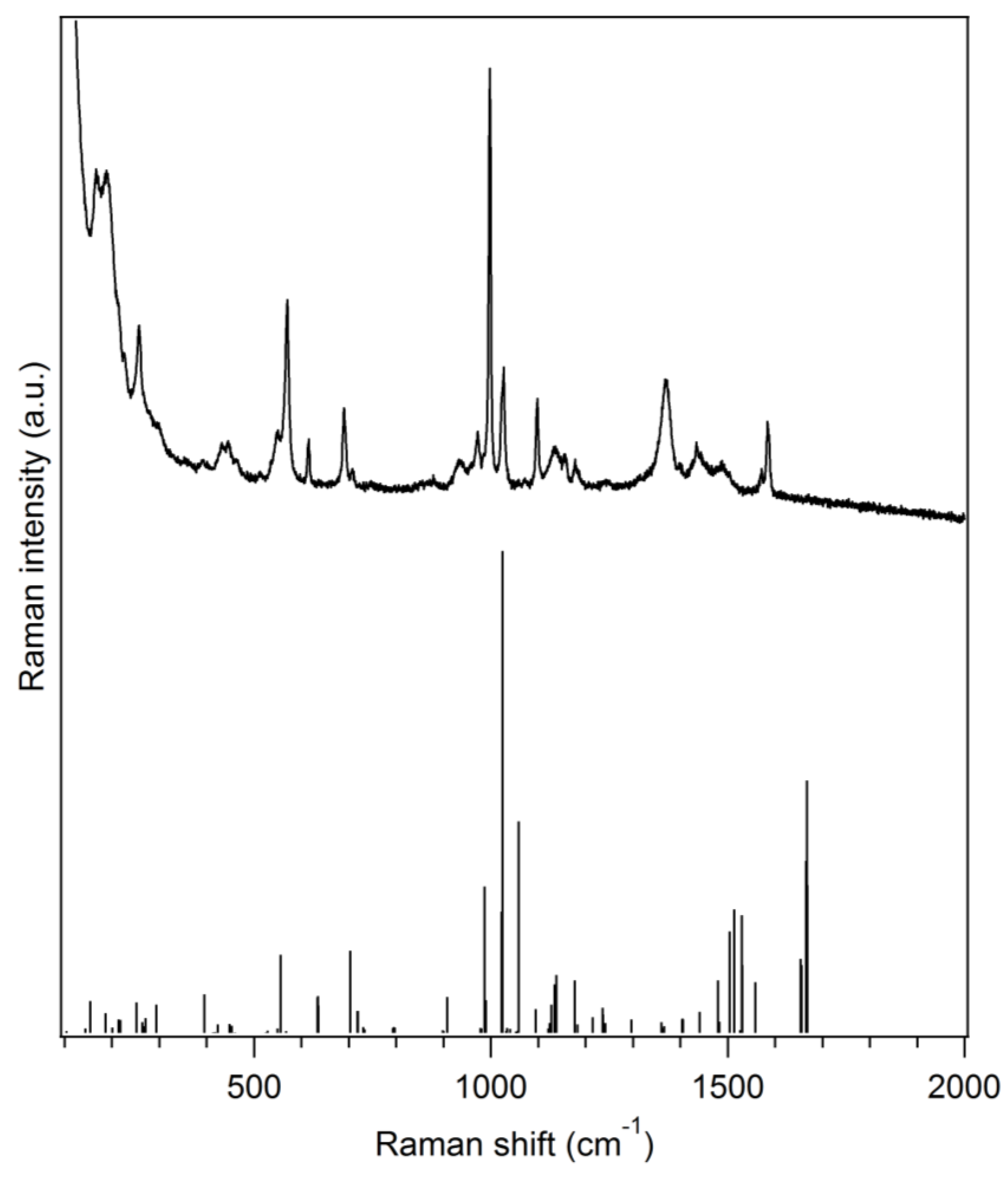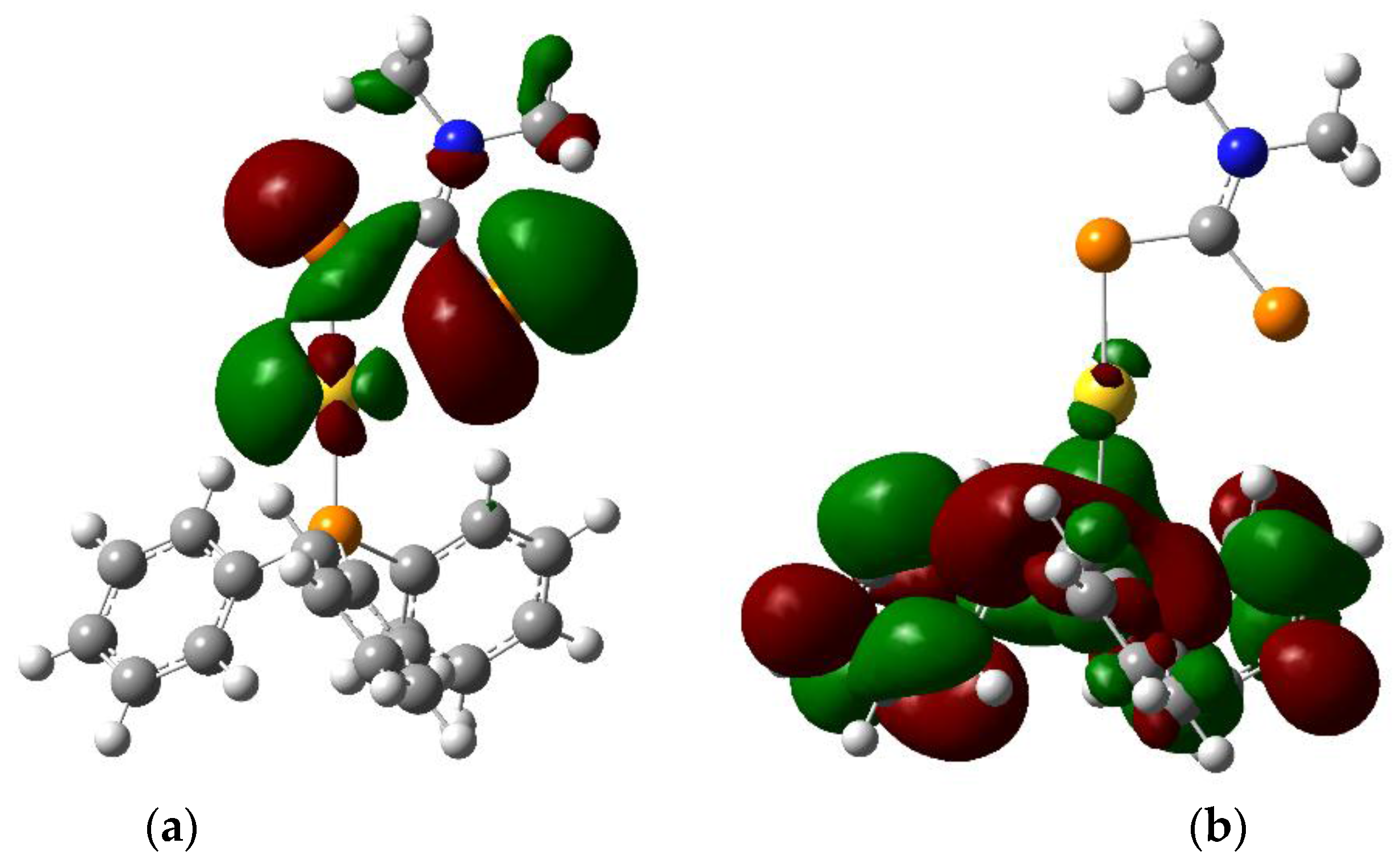Triphenylphosphine-(N,N-dimethyldithiocarbamato)-gold(I) Methanol Solvate
Abstract
:1. Introduction
2. Results and Discussion
2.1. X-ray Structures
2.2. Raman Spectroscopy
2.3. Frontier Orbitals
3. Materials and Methods
3.1. General Methods and Physical Measurements
3.2. Synthesis of (Ph3P)Au(S2CNMe2)·0.5CH3OH
3.3. DFT Calculations
Supplementary Materials
Acknowledgments
Author Contributions
Conflicts of Interest
References
- Wenger, O.S. Vapochromism in organometallic and coordination complexes: Chemical sensors for volatile organic compounds. Chem. Rev. 2013, 113, 3686–3733. [Google Scholar] [CrossRef] [PubMed]
- He, X.; Yam, V.W.-W. Luminescent gold(I) complexes for chemosensing. Coord. Chem. Rev. 2011, 255, 2111–2123. [Google Scholar] [CrossRef]
- Paliwoda, D.; Wawrzyniak, P.; Katrusiak, A. Unwinding Au+···Au+ bonded filaments in ligand-supported gold(I) polymer under pressure. J. Phys. Chem. Lett. 2014, 5, 2182–2188. [Google Scholar] [CrossRef] [PubMed]
- Baril-Robert, F.; Radtke, M.A.; Reber, C. Pressure-dependent luminescence properties of gold(I) and silver(I) dithiocarbamate compounds. J. Phys. Chem. C 2012, 116, 2192–2197. [Google Scholar] [CrossRef]
- Roberts, R.J.; Bélanger-Desmarais, N.; Reber, C.; Leznoff, D.B. The luminescence properties of linear vs. kinked aurophilic 1-D chains of bis(dithiocarbamato)gold(I) dimers. Chem. Commun. 2014, 50, 3148–3150. [Google Scholar] [CrossRef] [PubMed]
- Schmidbaur, H.; Schier, A. Aurophilic interactions as a subject of current research: An up-date. Chem. Soc. Rev. 2012, 41, 370–412. [Google Scholar] [CrossRef] [PubMed]
- Wijnhoven, J.G.; Bosman, W.P.J.H.; Beurskens, P.T. Crystal and molecular structure of triphenylphosphine (N,N-diethyldithiocarbamato)gold(I). J. Cryst. Mol. Struct. 1972, 2, 7–15. [Google Scholar] [CrossRef]
- Heinrich, D.D.; Wang, J.-C.; Fackler, J.P., Jnr. Structure of Au2[S2CN(C2H5)2]2, bis(diethyldithiocarbamato)digold(I). Acta Cryst. C 1990, 46, 1444–1447. [Google Scholar] [CrossRef]
- Bradley, D.C.; Gitlitz, M.H. Preparation and properties of NN-dialkyldithiocarbamates of early transition elements. J. Chem. Soc. A 1969, 1152–1156. [Google Scholar] [CrossRef]
- Song, Y.; Butler, I.S.; Shaver, A. High-pressure vibrational study of the catalyst candidate cis-dimercaptobis(triphenylphosphine)platinum(II), cis-[(Ph3P)2Pt(SH)2]. Spectrochim. Acta Part A 2002, 58, 2581–2587. [Google Scholar] [CrossRef]
- Dolomanov, O.V.; Bourhis, L.J.; Gildea, R.J.; Howard, J.A.K.; Puschmann, H. OLEX2: A complete structure solution, refinement and analysis program. J. Appl. Cryst. 2009, 42, 339–341. [Google Scholar] [CrossRef]
- Sheldrick, G. SHELXT - Integrated space-group and crystal-structure determination. Acta Cryst. 2015, A71, 3–8. [Google Scholar] [CrossRef] [PubMed]
- Sheldrick, G. A short history of SHELX. Acta Cryst. 2008, A64, 112–122. [Google Scholar] [CrossRef] [PubMed]
- Frisch, M.J.; Trucks, G.W.; Schlegel, H.B.; Scuseria, G.E.; Robb, M.A.; Cheeseman, J.R.; Scalmani, G.; Barone, V.; Mennucci, B.; Petersson, G.A.; et al. Gaussian 09, Revision E.01. Gaussian, Inc.: Wallingford, CT, USA, 2013. [Google Scholar]
- Adamo, C.; Barone, V. Toward reliable density functional methods without adjustable parameters: The PBE0 model. J. Chem. Phys. 1999, 110, 6158–6170. [Google Scholar] [CrossRef]
- Hay, P.J.; Wadt, W.R. Ab initio effective core potentials for molecular calculations. Potentials for the transition metal atoms Sc to Hg. J. Chem. Phys. 1985, 82, 270–283. [Google Scholar] [CrossRef]



| Bonds or Angles | Crystal Structure | DFT (PBE1PBE/Lanl2dz) | ||
|---|---|---|---|---|
| Exp. Bond Length (Å) or Angle (°) | Avg. Bond Length (Å) or Angle (°) | Calc. Bond Length (Å) or Angle (°) | Difference (%) | |
| Au–S | 2.3371 (15) | 2.335 | 2.427 | 4.0 |
| 2.3322 (15) | ||||
| Au---S | 3.1321 (19) | 3.091 | 3.151 | 1.9 |
| 3.0505 (16) | ||||
| Au–P | 2.2524 (15) | 2.255 | 2.364 | 4.8 |
| 2.2576 (14) | ||||
| C–S (S coord. to Au) | 1.756 (6) | 1.753 | 1.809 | 3.2 |
| 1.750 (7) | ||||
| C–S (S not coord. to Au) | 1.696 (6) | 1.702 | 1.743 | 2.4 |
| 1.708 (7) | ||||
| C–P | 1.815 (5) | 1.820 | 1.864 | 2.4 |
| 1.813 (6) | ||||
| 1.820 (6) | 1.862 | |||
| 1.833 (6) | ||||
| 1.820 (6) | 1.864 | |||
| 1.820 (6) | ||||
| C–N (dtc) | 1.331 (8) | 1.332 | 1.357 | 1.9 |
| 1.333 (8) | ||||
| S–Au–P angle | 173.66 (6) | 174 | 176 | 1.1 |
| 175.07 (5) | ||||
| S–C–S angle | 120.8 (4) | 120 | 122 | 1.0 |
| 119.9 (4) | ||||
© 2017 by the authors. Licensee MDPI, Basel, Switzerland. This article is an open access article distributed under the terms and conditions of the Creative Commons Attribution (CC BY) license (http://creativecommons.org/licenses/by/4.0/).
Share and Cite
Bélanger-Desmarais, N.; Reber, C. Triphenylphosphine-(N,N-dimethyldithiocarbamato)-gold(I) Methanol Solvate. Molbank 2017, 2017, M937. https://doi.org/10.3390/M937
Bélanger-Desmarais N, Reber C. Triphenylphosphine-(N,N-dimethyldithiocarbamato)-gold(I) Methanol Solvate. Molbank. 2017; 2017(2):M937. https://doi.org/10.3390/M937
Chicago/Turabian StyleBélanger-Desmarais, Nicolas, and Christian Reber. 2017. "Triphenylphosphine-(N,N-dimethyldithiocarbamato)-gold(I) Methanol Solvate" Molbank 2017, no. 2: M937. https://doi.org/10.3390/M937





